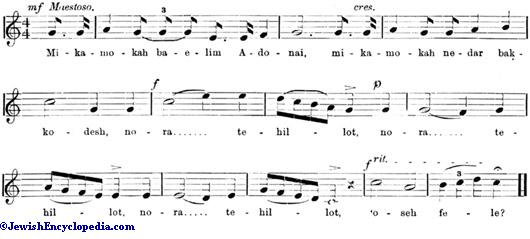Mi-Kamokah ("Who Is Like Unto Thee?")
 From Jewish Encyclopedia (1906)
From Jewish Encyclopedia (1906) Mi-Kamokah ("Who Is Like Unto Thee?"):
By: Cyrus Adler , Francis L. Cohen
Opening words of the verse Ex. xv. 11, which, with verse 18 of the same chapter ("Adonai Yimlok," etc.), is regularly employed as a response in the evening and morning services between the Shema' and the Shemoneh 'Esreh . Normally, as on week-days and ordinary Sabbaths, these verses are chanted to the melody-type in the free employment of which the particular service is intoned ( comp. Ḥazzanut ). In one case, indeed, the setting of "Mi-Kamokah" may have itself determined the intonation of the whole of the service in which it finds a place. This is the evening service of the Days of Penitence (New-Year to Day of Atonement), the traditional intonation of which is much later in style than that of any of the other services of the northern Jews. It differs from them very notably in its tonality also, which is that of the ordinary modern major mode, while the other services utilize scale-forms, surviving only in the early medieval plain-song of the Church, or in the folk-song of eastern Europe. This penitential setting is accordingly designated when "Mi-Kamokah" is itself quoted as an ancient melody; and it is given in the accompanying transcription.

To the use of "Mi-Kamokah" as a response is due also the introduction of the more recent custom into the northern liturgies according to which certain melodies, usually of post-medieval adoption, sung in the synagogue or in the home on special occasions, have come to be utilized as representative themes, and chanted as such not only with "Mi-Kamokah" and the opening verses of Ps. cxviii. ( see Hallel ), but also with other passages utilized on previous days as anticipatory references to the occasion. As an example may be cited the practise customary on the last Sabbath in the month, when the day of the ensuing new moon is announced to the melody representative of any festival or fast which may occur in the approaching month.
The first such melody utilized as a representative theme was probably that of Ma'oz Ẓur , the domestic hymn on the festival commemorating the triumph of the Maccabees, whose name, it was traditionally held, was itself compounded of the initial letters of the response "Mi-Kamokah baelim Adonai" ; so that the introducer of the custom saw an eponymous connection between the text of the response and the melody.
According to recent practise, "Mi-Kamokah" and the accompanying passages are chanted on special occasions to the following melodies, considered as representative of the respective occasions, viz.: Festivals (including intermediate Sabbaths):
| Passover |
|
| Pentecost |
|
| Tabernacles |
"Lulab" chant (see
|
|
Feast of Dedication (
|
|
|
Sabbaths in the '
|
|
|
Sabbaths between the fasts of
|
|
| At a circumcision | A melody specially introduced by the mohel into the morning service at references to "the covenant." |
- The traditional melodies are collected in Baer, Ba'al Tefillah, Nos. 26, 28, 30, 48b-51, 384-398, 533-535, 735-745, 974-977, 1050-1052, Frankfort-on-the-Main, 1883;
- Cohen and Davis, Voice of Prayer and Praise, Nos. 25, 50, 132-134, 189, 292 and 294, London, 1899.
Categories: [Jewish encyclopedia 1906]
↧ Download as ZWI file | Last modified: 09/04/2022 16:32:02 | 4 views
☰ Source: https://www.jewishencyclopedia.com/articles/10824-mi-kamokah.html | License: Public domain
 ZWI signed:
ZWI signed: KSF
KSF